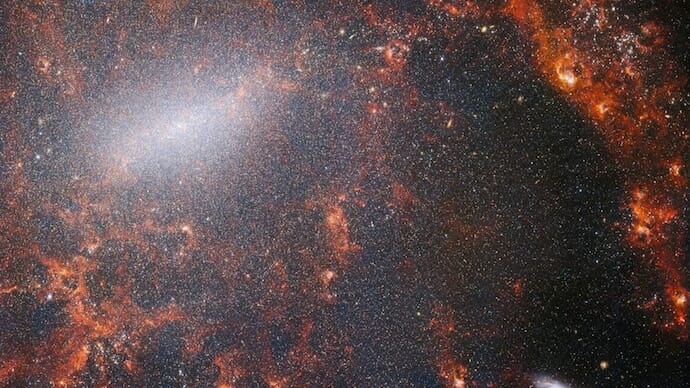In a remarkable astronomical revelation, the James Webb Space Telescope, akin to a cosmic soothsayer, has unveiled the wondrous spectacle of nascent suns springing to life in a far-flung galaxy.
Casting its discerning gaze upon the intricate tapestry of the galaxy NGC 5068, the telescope beheld a captivating feature—an entangled network of ethereal threads composed of dust and luminous star clusters.
Situated at a staggering distance of approximately 20 million light-years from our humble abode, this galactic masterpiece became the focal point of the world’s most formidable observatory. With unrivaled precision, the James Webb Space Telescope sought to unravel the secrets harbored within the radiant realms of star formation, a quest that forms an integral part of its celestial agenda.
Equipped with its advanced capabilities, the JWST assumed the mantle of a cosmic guardian, offering an unparalleled vantage point to scrutinize the intricacies of stellar genesis with unprecedented clarity and meticulousness.
These celestial observations serve a noble purpose, as they endeavor to unravel the intricate inner workings of galaxies, those celestial tapestries woven with cosmic threads. The National Aeronautics and Space Administration (NASA) expressed that star formation serves as the bedrock, underpinning a multitude of astronomical disciplines, from the ethereal physics governing the delicate plasma interspersed amidst stars to the intricate evolution of entire galaxies.
As part of its grand cosmic odyssey, the James Webb Space Telescope adorned its cosmic palette with captivating images from 19 neighboring star-forming galaxies. These cosmic portraits were skillfully blended with the splendid mosaics captured by the Hubble Space Telescope, showcasing a breathtaking compilation of 10,000 resplendent star clusters. In its insatiable hunger for knowledge, the JWST embarked on spectroscopic expeditions, mapping 20,000 lustrous star-forming emission nebulae with the aid of the Very Large Telescope (VLT). Furthermore, it cast its gaze upon the cosmos, identifying 12,000 enigmatic dark molecular clouds veiled within the vastness of space, courtesy of the Atacama Large Millimeter/submillimeter Array (ALMA).
Guided by the insatiable thirst for understanding, astronomers, like cosmic cartographers, endeavor to decipher the intricate cosmic choreography that initiates the waltz of star formation within galaxies. Webb’s invaluable data serves as their compass, their guiding light, illuminating the intricate steps that govern this celestial ballet.
Uniquely poised to peer through the cosmic veils of gas and dust enshrouding these newborn stars, the James Webb Space Telescope emerges as the maestro of cosmic exploration. Its prodigious infrared vision pierces through the celestial fog, unfurling a panorama of stellar nurseries obscured from view in the visible light spectrum, their secrets exposed in resplendent detail.
Bearing a remarkable segmented mirror, surpassing the collecting prowess of its celestial forebears, the JWST captures the faint yet mesmerizing infrared signals emitted by these youthful celestial entities. With its heightened light-gathering power, it embarks upon an extraordinary quest, capturing the whispers of newborn stars, resonating amidst their dusty abodes.
Let it be known that stars and planetary systems materialize within the ethereal embrace of swirling cosmic clouds, veiled from the prying eyes of visible-light observatories. Harnessing the wondrous capabilities of the Mid-Infrared Instrument (MIRI) and the Near-Infrared Camera (NIRCam), astronomers embark on a celestial voyage, peering unflinchingly through the colossal veils of dust enshrouding NGC 5068. Their endeavor captures the essence of stellar birth, immortalizing the magical process as it unfolds before their awe-stricken eyes.














